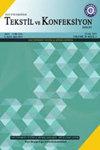Linear Model Equation for Prediction and Evaluation of Surface Roughness of Plain-Woven Fabric
IF 0.7
4区 工程技术
Q4 MATERIALS SCIENCE, TEXTILES
引用次数: 0
Abstract
Nowadays, evaluating fabric touch can be a great interest of industries to match the quality needs of consumers and parameters for the manufacturing process. Modeling helps to determine how structural parameters of fabric affect the surface of a fabric and also identify the way they influence fabric properties. Moreover, it helps estimate and evaluates without the complexity and time-consuming experimental procedures. In this research paper, the linear regression model was developed that was utilized for the prediction and evaluation of surface roughness of plain-woven fabric. The model was developed based on nine different half-bleached plain-woven fabrics with three weft Yarn counts 42 tex, 29.5 tex & 14.76 tex, and three weft thread densities (18 picks per c, 21ppc & 24 picks per c) and then the surface roughness of plain-woven fabric was tested by using Kawabata (KES-FB4) testing instrument. The findings reveal that the effects of count and density on the roughness of plain-woven fabric were found statistically significant at the confidence interval of 95%. The weft yarn count has a positive correlation with surface roughness values of plain-woven fabrics. On the other hand, pick density has a negative correlation with the surface roughness values of plain-woven fabrics. The correlation between measured surface roughness by KES-FB4 and calculated surface roughness by the model equation show how they are strongly correlated at 95% (R² of 0.97).平纹织物表面粗糙度预测与评价的线性模型方程
如今,评估织物触感可能是行业的一大兴趣,以匹配消费者的质量需求和制造过程的参数。建模有助于确定织物的结构参数如何影响织物的表面,并确定它们影响织物性能的方式。此外,它有助于估计和评估,而不需要复杂和耗时的实验程序。本文建立了用于平纹机织物表面粗糙度预测与评价的线性回归模型。以9种不同的半漂白平纹机织物为研究对象,采用42、29.5、14.76三种纬纱支数、18支/ c、21支/ c、24支/ c三种纬纱密度建立模型,并利用川边(KES-FB4)测试仪对平纹机织物的表面粗糙度进行测试。结果表明,计数和密度对平纹织物粗糙度的影响在95%的置信区间上具有统计学意义。纬纱支数与平纹机织物表面粗糙度值呈正相关。另一方面,纬纱密度与平纹机织物表面粗糙度值呈负相关。KES-FB4测量的表面粗糙度与模型方程计算的表面粗糙度之间的相关性表明,它们之间的相关性为95% (R²= 0.97)。
本文章由计算机程序翻译,如有差异,请以英文原文为准。
求助全文
约1分钟内获得全文
求助全文
来源期刊

Tekstil Ve Konfeksiyon
工程技术-材料科学:纺织
CiteScore
1.40
自引率
33.30%
发文量
41
审稿时长
>12 weeks
期刊介绍:
Tekstil ve Konfeksiyon, publishes papers on both fundamental and applied research in various branches of apparel and textile technology and allied areas such as production and properties of natural and synthetic fibers, yarns and fabrics, technical textiles, finishing applications, garment technology, analysis, testing, and quality control.
 求助内容:
求助内容: 应助结果提醒方式:
应助结果提醒方式:


